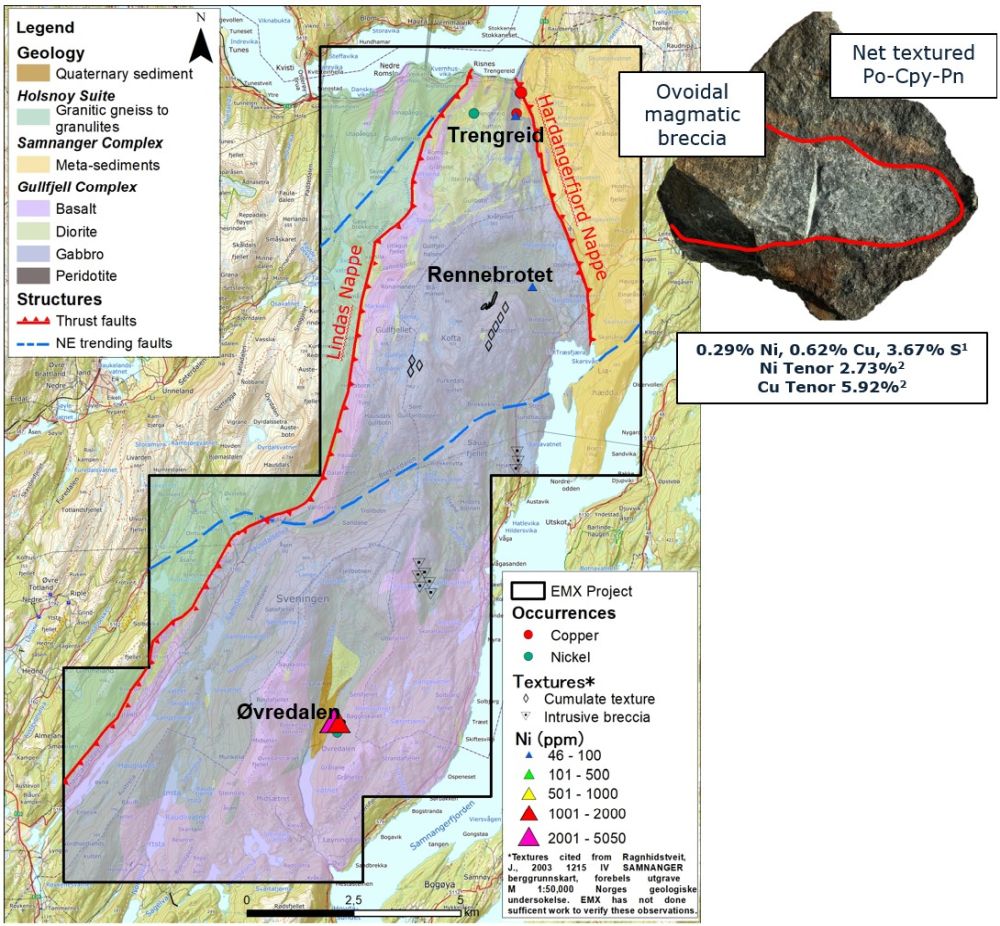Øvredalen
The Øvredalen project is located in southern Norway and displays many key characteristics of a fertile and productive magmatic system.
The host rocks consist of mafic to ultramafic lithologies within the Gullfjell Ophiolite Complex, which formed during the Ordovician. Historical 50K maps for the area show serpentinite outcrops in the project area, however, EMX staff recognized these outcrops are peridotite exposures instead. The surface footprint of the peridotite resembles a plug, suggesting a possible conduit in the subsurface.
Multiple sulfide styles observed in peridotite rocks from the Øvredalen historical dumps: 1) coarse and disseminated; 2) net-textured; 3) near-massive.
Key magmatic textures observed by EMX staff include cumulate zones and magmatic breccia. The presence of cumulate zones indicates the system has suitable traps for sulfide accumulation. EMX staff observed ovoidal magmatic breccia at Øvredalen and Rennebrotet, where barren ultramafic clasts sat in a net-textured sulfide matrix. This suggests a dynamic, high-heat flow environment that saw multiple magma pulses. The presence of net-textured sulfides is indicative of in-situ crystallization from an immiscible sulfide liquid and may indicate proximity to a parent conduit.
Geochemical results indicate Cu-Pd are strongly depleted in parts of the Øvredalen intrusion, indicating that Cu and Pd were removed and may have been sequestered in sulfide accumulations elsewhere in the system. Stream sediment sampling in 2023 identified new target areas with no mapped peridotite outcrops, indicating additional exploration upside.
1 EMX rock chip samples are collected in accordance with industry standard best practices. Samples are submitted to ALS in Malå, Sweden where they are prepped before being shipped to ALS in Galway, Ireland for analysis. Accredited control samples (blanks and accredited standards) are inserted into the sample suite regularly. Samples are dried, weighed, crushed (70% < 2mm), and riffle split into two fractions. One is retained (coarse reject) and the other is pulverized to 85% < 75µm. Pulps are analyzed by ultra-trace ICP-MS (ME-MS61) and ICP-AES Au-Pt-Pd (PGM-ICP23). Over detection limit samples are reanalyzed using ore grade ICP-AES by aqua regia (ME-OG62).
2 Tenor was calculated from the multielement geochemistry results from rock chip samples, using the formula: Ni ppm/(S%/35%), where 35% represents an average atomic sulfur content of Ni-Cu-bearing sulfide minerals.
Maps
Photos

 Click to Enlarge
Click to Enlarge